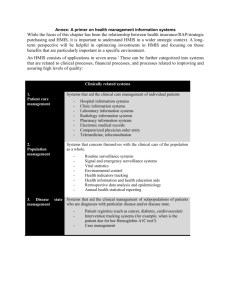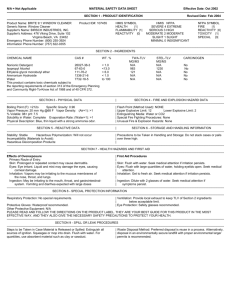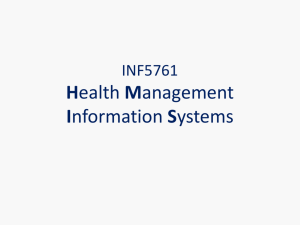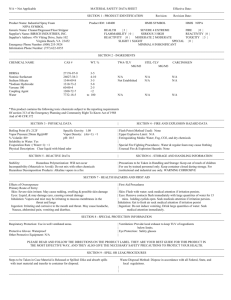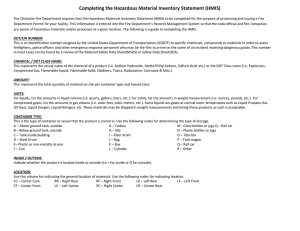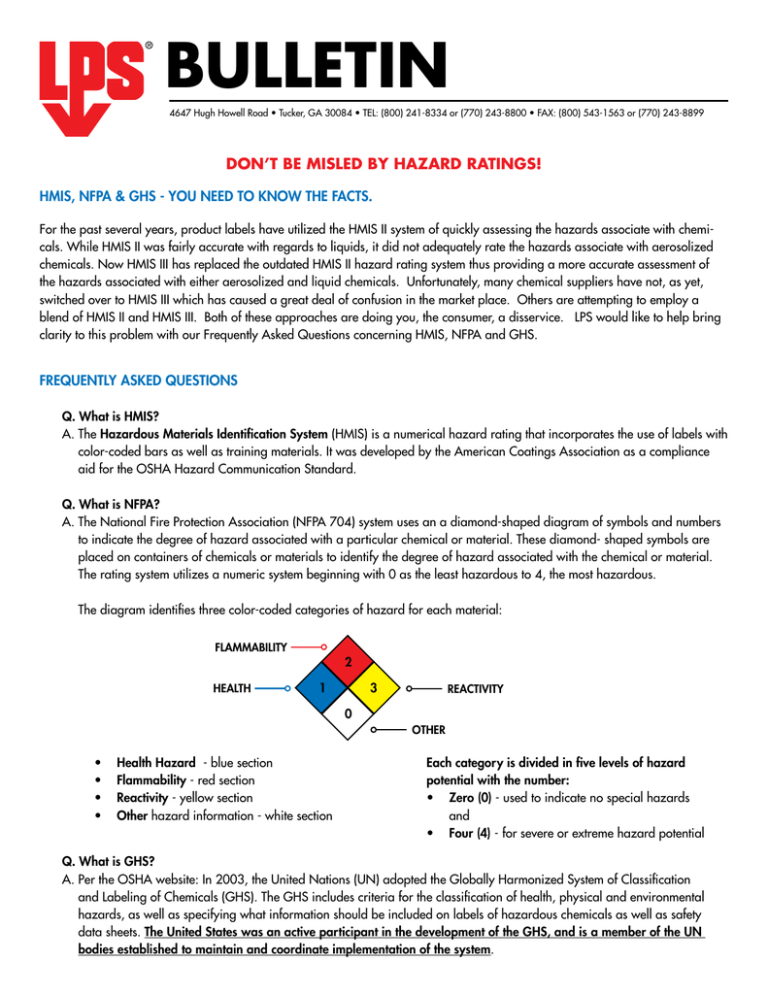
BULLETIN
4647 Hugh Howell Road • Tucker, GA 30084 • TEL: (800) 241-8334 or (770) 243-8800 • FAX: (800) 543-1563 or (770) 243-8899
DON’T BE MISLED BY HAZARD RATINGS!
HMIS, NFPA & GHS - YOU NEED TO KNOW THE FACTS.
For the past several years, product labels have utilized the HMIS II system of quickly assessing the hazards associate with chemicals. While HMIS II was fairly accurate with regards to liquids, it did not adequately rate the hazards associate with aerosolized
chemicals. Now HMIS III has replaced the outdated HMIS II hazard rating system thus providing a more accurate assessment of
the hazards associated with either aerosolized and liquid chemicals. Unfortunately, many chemical suppliers have not, as yet,
switched over to HMIS III which has caused a great deal of confusion in the market place. Others are attempting to employ a
blend of HMIS II and HMIS III. Both of these approaches are doing you, the consumer, a disservice. LPS would like to help bring
clarity to this problem with our Frequently Asked Questions concerning HMIS, NFPA and GHS.
FREQUENTLY ASKED QUESTIONS
Q. What is HMIS?
A. The Hazardous Materials Identification System (HMIS) is a numerical hazard rating that incorporates the use of labels with
color-coded bars as well as training materials. It was developed by the American Coatings Association as a compliance
aid for the OSHA Hazard Communication Standard.
Q. What is NFPA?
A. The National Fire Protection Association (NFPA 704) system uses an a diamond-shaped diagram of symbols and numbers
to indicate the degree of hazard associated with a particular chemical or material. These diamond- shaped symbols are
placed on containers of chemicals or materials to identify the degree of hazard associated with the chemical or material.
The rating system utilizes a numeric system beginning with 0 as the least hazardous to 4, the most hazardous.
The diagram identifies three color-coded categories of hazard for each material:
FLAMMABILITY
HEALTH
2
1
3
REACTIVITY
0
OTHER
•
•
•
•
Health Hazard - blue section
Flammability - red section
Reactivity - yellow section
Other hazard information - white section
Each category is divided in five levels of hazard
potential with the number:
• Zero (0) - used to indicate no special hazards
and
• Four (4) - for severe or extreme hazard potential
Q. What is GHS?
A. Per the OSHA website: In 2003, the United Nations (UN) adopted the Globally Harmonized System of Classification
and Labeling of Chemicals (GHS). The GHS includes criteria for the classification of health, physical and environmental
hazards, as well as specifying what information should be included on labels of hazardous chemicals as well as safety
data sheets. The United States was an active participant in the development of the GHS, and is a member of the UN
bodies established to maintain and coordinate implementation of the system.
Q. When HMIS III was released, did it replace HMIS II?
A. Yes, technically HMIS III replaced older versions of HMIS. However, many companies continue to use HMIS II creating
confusion in the industries served, because there are no rules or regulations in place on which rating system a company
has to use.
Q. Is LPS® transitioning to HMIS III?
A. Yes. LPS® decided to utilize HMIS III because most of the products LPS® sells are in aerosol form. HMIS III is the only
alternative labeling system that addresses aerosols. Other systems, such as NFPA and HMIS II, are designed around
liquids, not aerosols. LPS® believes in honest, accurate hazard communication and in utilizing the best tools that are
available in order to accomplish that goal.
Q. Does HMIS III require higher ratings for aerosol flammability and physical hazard than HMIS II and NFPA?
A. In many instances, HMIS III does require higher ratings for aerosols, even though the existing chemistry of the product has
not changed.
Q. Do these higher ratings mean that products have been reformulated and are now more hazardous?
A. In most cases, the higher ratings are simply due to the differences between the classification criteria for aerosols and
bulk liquids. Under HMIS II and NFPA, the lack of aerosol criteria caused manufacturers to use the classification criteria
for bulk liquids to determine the ratings for aerosols. HMIS III actually does a better job conveying hazards that were
always there.
Q. How is aerosol flammability different from the flammability of bulk liquids?
A. You need three things to start a fire; fuel, oxygen, and heat (ignition source). If you spray a liquid in an aerosol or trigger
sprayer you are essentially adding air (oxygen) to the liquid which by its very nature makes it more flammable around a
heat source. Think of building a fire with kindling versus logs. You have the same volume of fuel to ignite, yet one is more
flammable than the other because the kindling has more air space per square inch and more surface area than the logs.
Additionally, heat effects a smaller mass more quickly than a larger mass. A match will easily ignite the kindling but not
the logs. Now think of aerosol droplets as the kindling and a 5-gal pail of liquid as the logs. They both will burn, but the
aerosol droplets are much easier to ignite because they are smaller and surrounded by more air (oxygen).
Q. Can you provide an example of a product that would appear to be significantly more flammable under HMIS III than
under HMIS II or NFPA?
A. Yes, vegetable oil and hydraulic oil are examples of products that would be assigned higher ratings under HMIS III. Under
HMIS II and NFPA, these high flash point (less flammable) oils would be assigned a flammability rating of 1 regardless of
their delivery form. Under HMIS III, hydraulic oil or vegetable oil in a 1-gal jug would be assigned a 1 but aerosols would
be assigned a 4.
Q. Please explain why, under HMIS III, a product would receive a higher flammability rating in aerosol than in
non-aerosol forms.
A. Because the new criteria for aerosols uses heat of combustion*, not flash point**, to determine the rating, chemicals with
high flash points may be considered flammable. Any aerosol product with a heat of combustion greater than 30 kJ/g is
assigned a 4. This would include essentially any petroleum distillate, vegetable oil or mineral oil. Products dispensed via
trigger sprayer are not classified as aerosol but as bulk even though the spray is more flammable by nature.
Q. I thought flash point determined the flammability of a chemical.
A. Flash point is still the method used to assess the flammability of liquids. However, when liquids are aerosolized, their
flammable properties can change. Heat of combustion was found to be a better way of assessing the flammability of
aerosol products.
Q. HMIS ratings are 0 to 4 with 4 indicating the most severe hazard. Does the same scale apply to aerosols
under HMIS III?
A. HMIS III does use a 0 to 4 scale; however, some of those ratings do not apply to aerosols. For flammability, the usable scale
is 2 to 4. For physical hazard, the usable scale is 1 to 3 with most aerosols being rated 2.
Q. How can I tell if a manufacturer is using HMIS II or HMIS III on their label?
A. If you see an * in the health (blue) section, this is HMIS III. An * indicates that the product carries a chronic health risk.
This is not part of HMIS II or NFPA. Also, if you see an orange section labeled Physical Hazard, this is HMIS III. HMIS II and
NFPA use a yellow section labeled Reactivity and Instability.
HMIS®
HEALTH
FLAMMABILITY
PHYSICAL HAZARD
PERSONAL PROTECTION
HMIS III Example
HEALTH
FIRE
REACTIVITY
PPE
HMIS II Example
Q. I have seen HMIS III labels for aerosols that show a zero in both the flammability and physical hazard section.
Are those ratings correct?
A. No. The lowest flammability rating that can be assigned to an aerosol under HMIS III is a 2. The lowest physical hazard
rating that can be assigned to an aerosol is a 1, although most aerosols should be assigned a 2.
Q. Why would manufacturers underrate the hazards of their aerosol products?
A. Some manufacturers may not realize that different classification criteria apply to aerosols and may be using the liquid
classification criteria to rate aerosol products. Other manufacturers may not know how to address customer concerns
surrounding higher ratings and may fear losing sales as a result due to confusion and misinterpretation of the various
rating systems.
Q. I have heard that OSHA has released a new hazard communication standard (Hazcom 2012) that will require
substantial changes to labels and MSDSs. How does HMIS fit in?
A. HMIS III correlates fairly well with the aerosol classifications required under Hazcom 2012. HMIS II and NFPA, on the other
hand, may be conflicting in some cases. For example, an aerosol container of mineral oil propelled by CO2 would be
labeled “Extremely Flammable Aerosol” per Hazcom 2012 and would be assigned an HMIS III rating of 4. In this case,
the HMIS rating supports the “Extremely Flammable Aerosol” warning. However, if HMIS II or NFPA were used, the HMIS
rating would only be 1 given the fact that mineral oil (liquid not aerosolized) has a flash point over 300˚F. This clearly
would contradict the required “Extremely Flammable Aerosol” warning.
Q. Does a 2 for flammability under HMIS III mean an aerosol is non-flammable?
A. Generally speaking, non-flammable aerosols will be assigned the lowest available rating of 2. However, not all aerosols
assigned a 2 will be non-flammable. This is due to slight differences between Hazcom 2012 and HMIS III which make it
possible for some aerosols to be labeled “Flammable” but be assigned an HMIS rating of 2. This determination is product
specific and is made on a case by case basis. The main point to remember is that a rating of 2 indicates the lowest
flammability hazard for aerosol products.
Q. When is new labeling officially required to be implemented?
A. Effective 6/1/2015, all workplace products sold must comply with GHS/Hazcom 2012 labeling requirements. There is no
legal requirement to have alternative labeling such as NFPA or HMIS on the label. Most manufacturers include alternative
labeling on their products because there was no industry standard that was globally recognized to communicate hazards
until GHS/Hazcom 2012.
Q. What product labelling system will LPS® adopt?
A. LPS® has decided to remove the conflicting NFPA and HMIS label rating systems and adopt the more comprehensive GHS/
Hazcom 2012 labeling system.
Q. How will LPS® assist customers who wish to use NFPA or HMIS rating systems?
A. LPS® will be revising each product Technical Data Sheet (TDS) to reflect the product’s HMIS II, HMIS III and NFPA rating.
Product TDS’s can be found on the LPS® website at www.lpslabs.com.
Q. Does OSHA allow HMIS and/or NFPA to be used in conjunction with Hazcom 2012?
A. Yes, alternative labeling systems such as HMIS and NFPA may be used as long as they do not contradict the Hazcom 2012
warnings. LPS has decided to eliminate the chance of contradiction and confusion by standardizing on the GHS/Hazcom
2012 labeling system.
HMIS III vs HMIS II
COMPARISON OF FLAMMABILITY RATINGS
NON-AEROSOLS / LIQUIDS
RATING
4
(most
flammable)
HMIS II / NFPA
AEROSOLS
HMIS III
Flash point below 73°F and boiling
point below 100˚F
Same as
HMIS II
HMIS II / NFPA
Classification criteria for
aerosols does not exist
Examples: propane, lighter fluid
(butane)
LPS® Product Examples: None
3
Same as
HMIS II
Classification criteria for
aerosols does not exist
Flash point between 73°F and 100°F
®
Flash point between 100°F and 200°F
Examples: diesel fuel, mineral spirits,
kerosene (all grades)
Same as
HMIS II
Classification criteria for
aerosols does not exist
LPS® Product Examples: LPS 1®, LPS 2®,
LPS 3®, TKX®, PresSolve®, A-151
Flash point over 200°F
Examples: vegetable oil, mineral oil
Heat of combustion that is greater than
20 kJ/g but less than or equal to 30 kJ/g
LPS® Product Examples: U-10, EVR™,
G-49™, BrightCoat
LPS Product Examples: ZeroTri ,
CFC Free, Cold Galvanize
1
Generic Examples: mineral spirits with
CO2 propellant, vegetable oil with CO2
propellant
Generic Examples: acetone with CO2
propellant
Examples: xylene, acetone, gasoline,
methanol
2
Heat of combustion greater than 30 kJ/g
LPS® Product Examples: LPS 1®, LPS 2®,
LPS 3®, TKX®, PreSolve®, A-151,
CFC Free, Tapmatic® #1 Gold
Flash point below 73°F and boiling
point at or above 100°F
OR
®
HMIS III
Heat of combustion that is ≤ 20 kJ/g
Examples: methanol with CO2 propellant,
HFC-134a
LPS® Product Examples: ECC, NoFlash®,
ISD, HDX, QB Duster, HD Silicone,
Precision Clean
Same as
HMIS II
Classification criteria for
aerosols does not exist
None – this rating does not apply
Same as
HMIS II
Classification criteria for
aerosols does not exist
None – this rating does not apply
LPS® Product Examples: Tapmatic®
Natural, Tapmatic® #1 Gold
0
(least
flammable)
Will not burn
Examples: water, CO2, concrete, rocks
LPS® Product Examples: Aquacut,
Precision Clean
* Heat of combustion is the energy released when a fuel is burned. The higher the heat of combustion, the more energy is released and the better the fuel.
** Flash point is the lowest temperature at which the vapors above the liquid will ignite. The higher the flash point, the more a chemical has to be heated
before it will catch on fire.
LPS® Laboratories • An Illinois Tool Works Company
4647 Hugh Howell Road • Tucker, GA 30084 • TEL: (800) 241-8334 or (770) 243-8800 • FAX: (800) 543-1563 or (770) 243-8899
Internet Web Site: www.lpslabs.com
©2014 LPS® Laboratories • LPS®, LPS 1®, LPS 2®, LPS 3®, Tapmatic®, PreSolve®, TKX®, NoFlash®, and ZeroTri® are registered trademarks of Illinois Tool Works • All Rights Reserved • Rev. 2/2014

